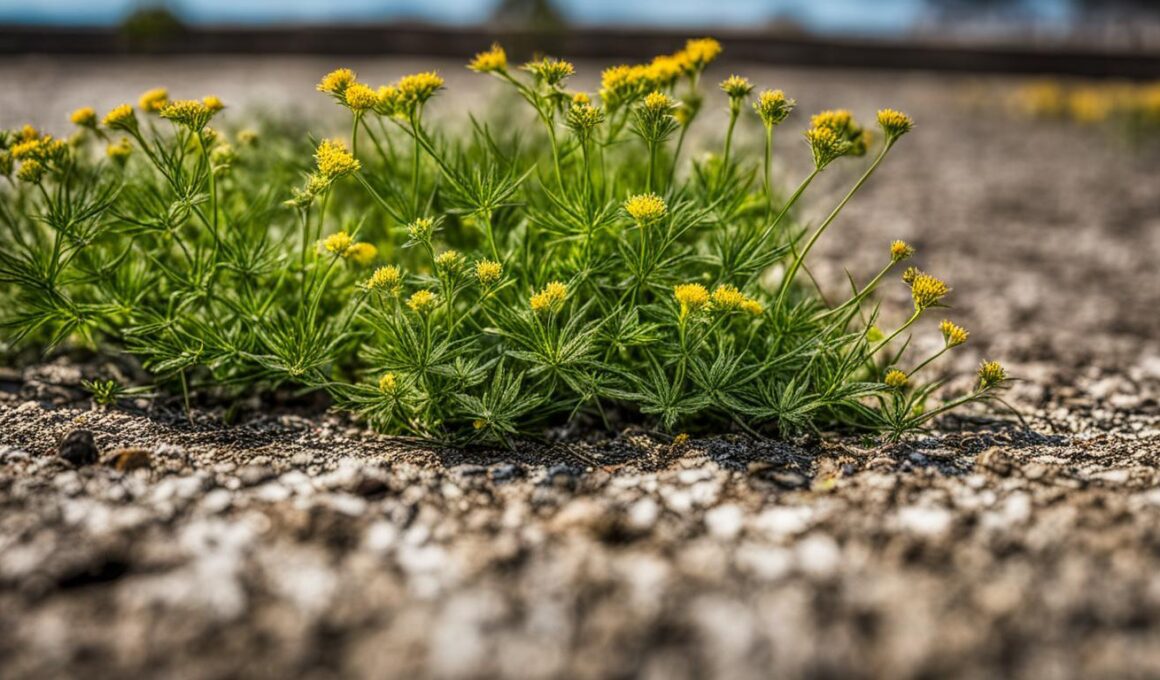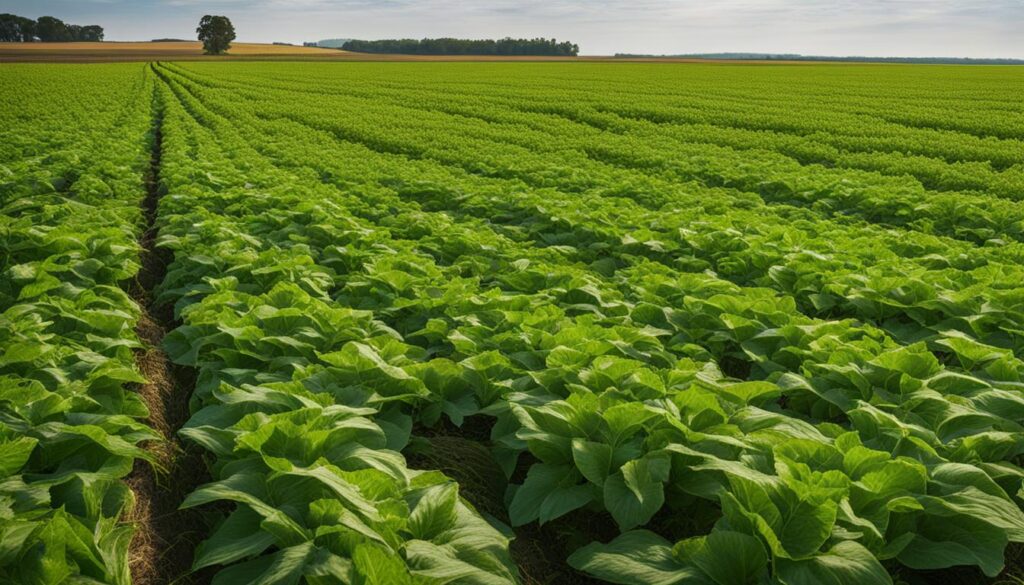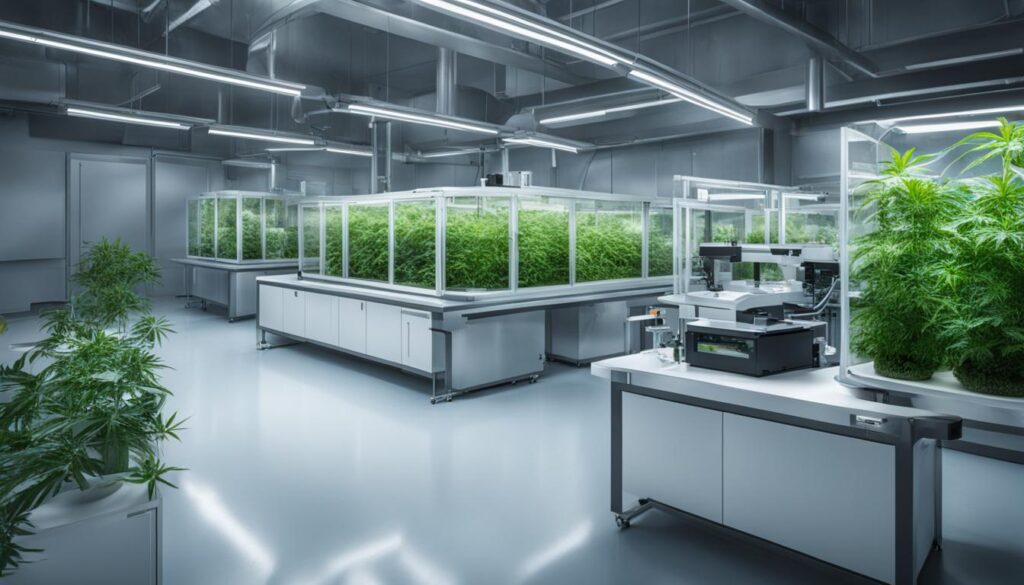In this article, we will explore the paradox of weeds and delve into their potential benefits in the ecosystem. While weeds have long been viewed as a nuisance, it’s important to question whether they are truly all bad. By examining their role in nature, we can gain a deeper understanding of their impact and the complexities of their existence.
Key Takeaways:
- Weeds have a paradoxical nature, with both negative and positive impacts on ecosystems.
- Wilderness areas play a crucial role in biodiversity conservation.
- The concept of wilderness management is contradictory, as it involves regulating and altering natural environments.
- Ralph Waldo Emerson used flowing rivers as a metaphor for the interconnectedness of humans and nature.
- Pesticides have been the primary means of weed control, but their use raises ethical concerns.
The Importance of Wilderness Areas for Biodiversity Conservation
Wilderness areas play a vital role in the conservation of biodiversity. These vast expanses of untouched natural habitats provide a refuge for countless plant and animal species, allowing them to thrive undisturbed by human activities. The preservation of wilderness areas is crucial for maintaining the delicate balance of ecosystems and protecting the rich diversity of life they support.
Wilderness areas are characterized by their limited human intervention, allowing nature to take its course without significant human interference. This hands-off approach allows for the uninterrupted evolution of species and the natural processes that shape ecosystems. As a result, wildlife populations in wilderness areas are often more abundant and diverse compared to areas affected by human activities.
Conservation-reliant species, such as grizzly bears and wolves, heavily rely on wilderness areas for their survival. These large predators require vast territories to roam and hunt, and wilderness areas provide the necessary space and resources for their populations to thrive. By protecting these areas and allowing them to remain untouched, we ensure the long-term survival of these iconic species and maintain the delicate ecological balance they contribute to.
Preserving wilderness areas is not only important for the sake of biodiversity but also for the well-being of future generations. These pristine landscapes offer a sense of awe and wonder, providing opportunities for people to connect with nature and experience its beauty firsthand. By safeguarding wilderness areas, we ensure that future generations can continue to enjoy the benefits of these natural wonders and the countless ecological services they provide.
| Benefits of Wilderness Areas for Biodiversity Conservation | Examples |
|---|---|
| Protection of endangered species | Preservation of habitats for species like the grizzly bear and gray wolf |
| Maintenance of ecological balance | Prevention of ecosystem disruptions caused by human activities |
| Opportunities for scientific research | Studying natural processes and species interactions in undisturbed environments |
| Recreation and ecotourism | Providing scenic landscapes for outdoor activities and nature appreciation |
The Role of Wilderness Areas in Biodiversity Conservation
Wilderness areas serve as important sanctuaries for biodiversity, enabling the preservation of fragile ecosystems, protecting endangered species, and maintaining ecological balance. These pristine landscapes provide a glimpse into the natural world as it was before human intervention, reminding us of the critical need to protect and conserve these valuable wilderness areas for future generations.
The Contradiction of Wilderness Management: Balancing Preservation and Human Needs
The concept of wilderness management is a paradoxical one. On one hand, wilderness areas are meant to be spaces untouched by human intervention, preserving the natural state of the environment. On the other hand, wilderness areas have been subject to regulation and alteration to serve human needs and preserve certain species. This contradiction raises important questions about the true purpose and effectiveness of wilderness management.
While the initial intention of wilderness management was to preserve untouched and uncontrolled environments, the reality is that human activities have had significant impacts on wilderness areas. This includes activities such as logging, hunting, and infrastructure development, all of which contradict the original idea of preserving these spaces in their natural state.
Moreover, the management of wilderness areas often aims to balance conflicting objectives, such as protecting biodiversity, providing recreational opportunities, and supporting economic activities. These competing interests can create challenges in finding a harmonious approach to managing wilderness areas. Decisions regarding the allocation of resources and the implementation of regulations become complex and are often subject to debates and criticism.
Challenges in Wilderness Management
One of the main challenges in wilderness management is finding a balance between preservation and human needs. Striking the right balance involves considering ecological integrity, cultural values, and economic considerations. It requires careful assessment of the potential impacts of human activities on the natural environment and the long-term sustainability of both the ecosystem and the surrounding communities.
Additionally, wilderness management must navigate through the ethical and moral dilemmas associated with preserving wilderness areas. The value of nature itself, its intrinsic value, often clashes with the utilitarian perspective that emphasizes human needs and economic growth. This contradiction adds complexity to the decision-making process and requires a thoughtful examination of society’s values and priorities.
In conclusion, wilderness management faces a contradiction between the original vision of preserving untouched environments and the reality of human interventions and conflicting interests. Striking a balance between preservation and the needs of society is a complex task that requires careful consideration of ecological, cultural, and economic factors. However, acknowledging this contradiction and engaging in open discussions can pave the way for more sustainable and effective approaches to wilderness management.
Emerson’s Vision: Flowing Rivers as a Symbol of the Self
In his influential book “Nature,” Ralph Waldo Emerson explores the intricate connection between humanity and the natural world. Throughout his writing, he often uses the metaphor of flowing rivers to symbolize the profound interconnectedness between humans and nature. According to Emerson, rivers represent the self-willed and autonomous condition that distinguishes the natural world from other environments.
“The river is everywhere at once, at the source and at the mouth, at the waterfall, at the ferry, at the rapids, in the sea, in the mountains, everywhere at the same time, and still the same river everywhere.”
“As the flowing river connects one place to another, so too does it connect our individual selves with the larger whole of the natural world. Just as a river cannot be confined or controlled, our own true selves cannot be limited by societal constraints or the expectations of others. By immersing ourselves in nature and embracing the free-flowing spirit of the river, we can tap into our innermost essence and find a deeper sense of meaning and purpose.”
Emerson’s vision of flowing rivers as a symbol of the self serves as a reminder of the profound connection between humanity and the natural world. It encourages us to embrace our innate autonomy and authenticity, much like the untamed currents of a river. By recognizing our place within the larger tapestry of nature, we can develop a greater appreciation for the beauty and interconnectedness of all living things.
| Rivers as a Symbol of the Self | |
|---|---|
| Representative of | The interconnectedness of humans and nature |
| Metaphorically Represents | Autonomy and authenticity |
| Emphasizes | The importance of embracing our true selves |
| Highlights | The interconnectedness of all living things |
The Role of Pesticides in Weed Control
In the realm of weed science, pesticides have long been regarded as the cornerstone of effective weed control. Pesticides, particularly herbicides, have been the go-to solution for managing and eliminating unwanted plant species that compete with crops or disrupt natural ecosystems. The use of pesticides has revolutionized weed management practices, providing a powerful tool to combat problematic weeds and maintain agricultural productivity.
However, the reliance on pesticides raises important questions regarding their necessity and potential risks to the environment and human health. While pesticides have undoubtedly played a crucial role in weed control, concerns have emerged about their long-term impact on biodiversity, water quality, and human safety.
It is essential to strike a balance between the benefits of weed control through pesticide use and the potential negative consequences. This necessitates a comprehensive evaluation of alternative methods and a judicious approach to pesticide application. Integrated Pest Management (IPM) strategies, which combine various management practices, including chemical, biological, and cultural methods, can offer a more sustainable and environmentally friendly approach to weed control, minimizing the reliance on pesticides alone.
H3: Potential Risks Associated with Pesticide Use
While pesticides have been instrumental in managing weeds, their indiscriminate use can pose several risks to the ecosystem and human health. The widespread application of pesticides can result in the contamination of water bodies, affecting aquatic life and threatening water resources. Additionally, pesticide residues can persist in the soil, impacting beneficial microorganisms and disrupting soil health and fertility.
Furthermore, there is growing concern about the potential adverse effects of pesticide exposure on human health. Pesticides can enter the food chain through residue accumulation, potentially causing harmful effects on consumers. Occupational exposure to pesticides during application poses risks to agricultural workers, highlighting the need for strict safety measures and regulations in pesticide use.
| Potential Risks | Impact |
|---|---|
| Environmental contamination | Threat to water quality and biodiversity |
| Soil degradation | Disruption of soil health and fertility |
| Human health risks | Possible harmful effects through ingestion and occupational exposure |
To address these concerns, researchers and policymakers are exploring alternative weed control strategies that minimize pesticide use. These include cultural practices like crop rotation and cover cropping, mechanical methods such as tillage and hand-weeding, and biological approaches like biocontrol agents. By integrating these alternatives into weed management plans, the negative impacts associated with pesticide use can be mitigated, promoting a more sustainable and environmentally conscious approach to weed control.
Debating the Moral Obligation of Agricultural Technology
When it comes to agricultural technology, there is an ongoing debate surrounding the moral obligation associated with its use. On one hand, agricultural technology has undeniably revolutionized the industry, leading to increased food production and improved public health. Through the use of advanced machinery, genetically modified organisms, and pesticides, farmers are able to maximize crop yields and protect their harvests from pests and diseases.
However, the moral justification for the widespread use of agricultural technology remains a topic of contention. Critics argue that the reliance on these technologies has led to a loss of biodiversity, soil degradation, and the potential harm to human health and the environment. They question whether the benefits of increased productivity outweigh the potential risks and emphasize the importance of sustainable and environmentally friendly farming practices.
In this moral dilemma, it is essential to consider the long-term consequences of our actions. While agricultural technology has undoubtedly provided short-term solutions to feeding a growing population, we must also evaluate the impact of these practices on future generations. It is our responsibility to find a balance between maximizing productivity and preserving the health and integrity of our planet.
As we navigate the complex landscape of agricultural technology, it is crucial to engage in open discussions that incorporate both scientific evidence and ethical considerations. By critically examining the necessity and potential harms of agricultural technologies, we can make informed decisions that prioritize the well-being of people, animals, and the environment. The moral obligation of agricultural technology extends beyond short-term gains and requires us to carefully consider the long-term sustainability and impact of our actions.
The Paradigm Shift and Future of Weed Science
As society becomes more aware of the potential risks associated with pesticide use, there is a growing need for a paradigm shift in weed science. The traditional reliance on herbicides as the primary means of weed control is no longer sustainable in the long term. The future of weed science lies in exploring alternative methods that are more environmentally friendly and promote sustainable agricultural practices.
This shift towards more holistic and integrated approaches to weed management requires open discussions and collaboration among scientists, farmers, policymakers, and other stakeholders. It is crucial to consider both scientific evidence and value-laden arguments to strike a balance between effective weed control and the preservation of biodiversity.
One promising avenue for the future of weed science is the exploration of biological control methods. This involves harnessing the power of natural predators, such as insects or microbial organisms, to control weed populations. By leveraging natural ecological processes, we can potentially reduce the reliance on chemical interventions and minimize the negative impacts of pesticides on the environment.
Advantages of Biological Control Methods:
- Naturally sustainable and environmentally friendly
- Minimizes the need for synthetic pesticides
- Potentially long-lasting effects with minimal resistance development
However, it is important to note that biological control methods are not without their challenges. They require careful research and implementation to ensure their effectiveness and avoid unintended consequences. Additionally, ongoing research is needed to develop new tools and technologies that optimize the use of biological controls in various agricultural systems.
In conclusion, the future of weed science lies in embracing a paradigm shift towards more sustainable and environmentally friendly approaches to weed control. The exploration of alternative methods, particularly biological controls, holds great promise for reducing the reliance on pesticides and minimizing their negative impacts. By fostering collaboration and open dialogue, we can collectively shape the future of weed science and move towards a more sustainable and resilient agricultural system.
What Are the Benefits of Weeds in the Natural Environment?
Weeds play a crucial role in the natural environment. Their fast growth helps prevent soil erosion, while their deep roots break up compacted soil. Weeds also provide food and habitat for wildlife, supporting biodiversity. The mystery of leaf lines adds to their unique beauty and contribution to the ecosystem.
Conclusion
In conclusion, the debate surrounding the nature of weeds is far from definitive. It is not a simple matter of categorizing them as either good or bad. Weeds can have both positive and negative impacts on ecosystems, and their significance depends on your perspective.
On one hand, weeds can play a vital role in maintaining biodiversity by providing habitat and food sources for various species. They are often resilient and adaptable, contributing to ecological resilience in the face of environmental changes. Weeds can also offer valuable medicinal properties and serve as indicators of soil health.
On the other hand, weeds can become invasive and outcompete native plants, disrupting the balance of ecosystems. In agricultural settings, they can pose significant challenges by reducing crop yields and depleting resources. The management and control of weeds is a complex task, requiring careful consideration of the ecological, economic, and social implications.
As we move forward, it is crucial to continue research and explore sustainable and environmentally friendly methods of weed control. By striking a balance between managing weeds and preserving biodiversity, we can aim for a more harmonious coexistence with these often misunderstood plants. The future of weed science lies in the pursuit of effective strategies that minimize harm to the environment while meeting the needs of society.
FAQ
Are weeds always harmful to ecosystems?
Weeds can have both positive and negative impacts on ecosystems. Some weeds, like invasive species, can harm native plants, while others provide habitat and food for wildlife.
Do wilderness areas play a role in preserving biodiversity?
Yes, wilderness areas are crucial for preserving biodiversity. They provide a protected habitat for various plant and animal species, allowing them to thrive without human interference.
What is the paradox of wilderness management?
The concept of wilderness management is contradictory because wilderness is meant to be untouched and uncontrolled by humans. However, wilderness areas have been regulated and altered to preserve certain species and accommodate human needs.
How does Ralph Waldo Emerson use rivers as a metaphor in his book “Nature”?
Emerson uses flowing rivers as a symbol for the interconnectedness between humans and the natural world. Rivers represent the autonomous and self-willed condition of nature that sets it apart from other environments.
What is the primary means of weed control in weed science?
Weed science has traditionally relied on the use of pesticides, particularly herbicides, as the primary means of weed control.
Are the benefits of agricultural technology justified?
The moral justification for the use of agricultural technology, including herbicides, remains a topic of debate. While it has led to increased food production and improved public health, the potential risks and ethical considerations require ongoing examination.
What is the future direction of weed science?
There is a need for a paradigm shift in weed science towards more environmentally friendly and sustainable methods of weed control. Future research should explore alternative approaches that minimize the use of pesticides.











